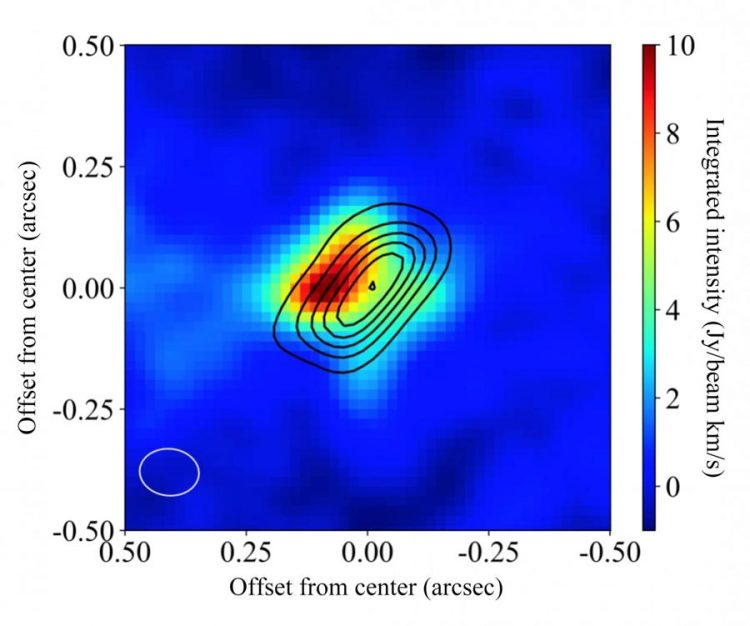ALMA discovers aluminum around young star

ALMA image of the distributions of AlO molecules (color) and warm dust particles (contours). The molecular outflow (not shown in this image) extends from the center to the top-left and bottom-right. Credit: ALMA(ESO/NAOJ/NRAO), Tachibana et al.
Young stars are surrounded by disks of gas. Some of the gas condenses into dust grains which then stick together to form larger objects, building up to form meteors, planetesimals, and eventually planets.
Understanding the formation of these first solid objects is important for understanding everything which follows.
Shogo Tachibana, a professor at the University of Tokyo/Japan Aerospace Exploration Agency (JAXA), and his team analyzed the ALMA (Atacama Large Millimeter/submillimeter Array) data for Orion KL Source I, a young massive protostar, and found distinctive radio emissions from aluminum oxide (AlO) molecules. This is the first unambiguous detection of AlO around a young star.
“Aluminum oxide played a very important role in the formation of the oldest material in the Solar System,” says Tachibana “Our discovery will contribute to the understanding of material evolution in the early Solar System.”
Interestingly, the radio emissions from the AlO molecules are concentrated in the launching points of the outflows from the rotating disk around the protostar. In contrast, other molecules such as silicon monoxide (SiO) have been detected in a wider area in the outflow. Normally, the temperature is higher at the base of the outflows and lower in the downstream gas.
“Non-detection of gas-phase AlO downstream indicates that the molecules have condensed into solid dust particles in the colder regions,” explains Tachibana. “Molecules can emit their distinctive radio signals in gas-phase, but not in solid-phase.”
ALMA's detection of AlO in the hot base of the outflow suggests that the molecules are formed in hot regions close to the protostar. Once moved to colder regions, AlO would be captured in dust particles which can become aluminum-rich dust, like the oldest solid in the Solar System, and further the building blocks for planets.
The team will now observe other protostars looking for AlO. Combining the new results with data from meteorites and sample return missions like JAXA's Hayabusa2 will provide important insights into the formation and evolution of our Solar System and other planetary systems.
Media Contact
All latest news from the category: Physics and Astronomy
This area deals with the fundamental laws and building blocks of nature and how they interact, the properties and the behavior of matter, and research into space and time and their structures.
innovations-report provides in-depth reports and articles on subjects such as astrophysics, laser technologies, nuclear, quantum, particle and solid-state physics, nanotechnologies, planetary research and findings (Mars, Venus) and developments related to the Hubble Telescope.
Newest articles

Sea slugs inspire highly stretchable biomedical sensor
USC Viterbi School of Engineering researcher Hangbo Zhao presents findings on highly stretchable and customizable microneedles for application in fields including neuroscience, tissue engineering, and wearable bioelectronics. The revolution in…

Twisting and binding matter waves with photons in a cavity
Precisely measuring the energy states of individual atoms has been a historical challenge for physicists due to atomic recoil. When an atom interacts with a photon, the atom “recoils” in…

Nanotubes, nanoparticles, and antibodies detect tiny amounts of fentanyl
New sensor is six orders of magnitude more sensitive than the next best thing. A research team at Pitt led by Alexander Star, a chemistry professor in the Kenneth P. Dietrich…





















